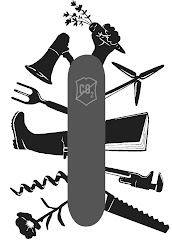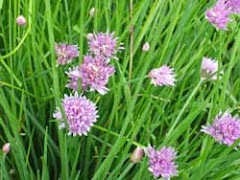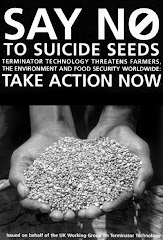I’m sure I’ve always composted tea bags, long before I ever composted anything else. In one house I used to just chuck them out in the garden straight from the kitchen window, since they don’t smell as they break down and apparently some plants like a bit of caffeine. I drink a lot of tea and I’ve never thought twice about composting the bags – it seems obvious, and I’ve been doing it so long I can’t remember where I first got the idea.
I’ve just used the last of this year’s compost on my seedlings, and emptying the bin this year I’ve had unpleasant surprises*. Pulling out odd pieces of plastic and woody bits I kept finding fluffy white fibrous stuff stuck in there, like duvet filling in small patches stuck fast to and tangled up with everything else. I pulled one out after another but they kept appearing, so I looked at different parts of the pile and found them spread out through the whole heap. Even the blackest, crumbliest parts had these stupid blobs in them, either solid little black lumps in stringy white** mesh bags, or stringy white mesh bags full of worms.
I’ve had several thousand cups of tea since I last emptied the compost bin and I’ve put every single used tea bag into the damned thing, and now every single one is sitting there waiting for me to take it out before I can use a year’s worth of compost. Since when are teabags not made of PAPER???
It’s dead fashionable to compost these days – even the Guardian is explaining how to do it – so there are millions of sites, books, factsheets and community projects out there to tell anyone who’ll listen how to put things in a pile and leave it alone for a while. After trawling through a few of them and rolling my eyes quite a lot (Q: My compost bin is full of pests! After only two weeks it’s all full of horrible woodlice and millipedes – what did I do wrong?) I finally submitted a question to WRAP.
After a long time, I got this back:
“The answer is that not enough companies specify their tea bag materials, which can be plastic or paper based. So, two batches of tea bags from the same tea company may have used different materials. You will need to contact the tea bag company I am afraid.”
Right. They get together a big organisation for “supporting compost producers and growing markets for compost products”, but encouraging tea bag producers to create something I can put IN my compost is left to me the individual. Thanks a lot.
I did give up at this point, but then another hour pulling all the little white mesh bags full of worms out of my compost spurred me on again to find a contact e-mail for “the tea bag company” and ask them. I got this reply:
“Thank you for your email and your comments. I would like to confirm to you that our Teadirect teabags are made from polyester which is fairly typical for all teabags as far as I am aware. Yes you are right, unfortunately they are non-recyclable and non-biodegradable.. The best method for disposal is to burn for heat recovery. I would be very grateful of any feedback you have with regards to any alternative teabags that you have come across which I would gladly pass onto our marketing department for their consideration as we are continually carry out research to find more environmentally friendly products. I look forward to hearing from you.”
How many tea bags would I have to burn to boil a kettle then?
Strangely enough, when they’re dry they do burn remarkably well, which leaves me with no way of telling which tea bags are still made from paper, since the usual test for man-made fibres is that they melt slightly (or a lot) when you burn them.
So, the question now is this; should I a) try to make WRAP or maybe the Guardian lifestyle and fashion department compile a list of compostable tea bags, b) ask all the tea bag companies myself which would be more hassle but quicker, or c) get a life, stop composting my tea bags and experiment with using loose-leaf tea, which would probably be more hassle in the end over the course of a lifetime.
Answers on a postcard if you wish, so long as it’s a bloody PAPER postcard.
* The first few were surprising anyway. The next 6000 were just unpleasant.
** Fellow gardeners will appreciate the meaning of “white” in the context of a compost bin compared to the meaning of “white” in, say, a Persil ad.
COMMENTS
Thursday, 24 May 2007
Subscribe to:
Post Comments (Atom)

















11 comments:
I knew there was a reason why I drank coffee. I'd always put it down to being too lazy and imatient to wait for the teabag to percolate. Also, not many teas other than green tea (and Earl Grey) are pleasant black (vegan and have always hated milk). Green tea is best loose (I could add something rude here but I won't) and you can just throw the dead leaves on the garden. Could you get one of those twee loose tea leaf holders and do away with teabags altogether?
...I'm too impatient to spell properly also!
wow.. I really had no idea. I've been bunging my used tea bags on the compost heap too. And I buy Teadirect tea. DAMN! my old housemates used to tear their teabags open before putting them in the compost caddy. Perhaps try tearing and emptying them?? or perhaps switching brands... sigh.
After extensive research I've discovered that Clipper tea bags are still made of paper. I found out quite a few random things about tea bags after extensive research and might write another blog on the subject eventually, but Clipper is both compostable and fair trade so that should sort you out for now.
I must admit I'm relieved to find that anyone else cares!
How much research do they need to do to find out what they USED to use before plastic?
All heatseal teabags(roughly, but not always, the ones without a string and tag) contain an amount of plastic fibres. This plastic is usually polypropylene, polyethylene or a blend of the two. These fibres melt to create the heatseal to close the bag. The UK government states that teabags are compostable. The very fine fibre mesh that you refer to will generally break up when the compost is turned, and can in fact improve soil structure.
Clipper teabags, like all other heatseal bags, use these same plastic fibres to seal the bags.
The alternative would be to buy the string and tag bags - try and get the ones without the aluminium staple in though, and also ones that are not individually wrapped in a paper/foil laminate (not compostable).
Just found this quickly this mornign after opening a loverly tin of Harney tea adsn finding a Odd New Sort Of Teabag... sheer in the extreme and obviously heat-edge-sealed... PLASTIC???
and here I am.
The answer I see is to go back to tea teh right way (!) loose in a proper teapot.. no bags, no extra anything.
Glad to see the mention of CLIPPER. I'm there
THANK you s much
John V
Thank you for your info. I am new to composting. In fact, this is my first year. Thanks to your post, I will save myself some trouble and will tear them open first.
I am thinking of inviting my colleagues to let me have their tea bags as they get through dozens of the things each day. Many put milk in their cups before they remove the teabag - will this make them unsuitable for the compost heap?
CH - the minuscule amount of milk that might soak into the bags will not cause any problems. I often add milk before removing the teabag but all of mine go on the heap and break down just fine. (I use Yorkshire Tea and the bags seem to rot down OK - I sometimes see a bit of "mesh" but it soon breaks down.)
I think there was a story a year or two ago about teabags being classed as unsuitable for council composting schemes because of the potential milk contamination, but that's just council health n safety jobsworthiness.
you have saved me quite a bit of bother i would have thrown them straight in but i know not to thanks
fionntan belfast...
Post a Comment